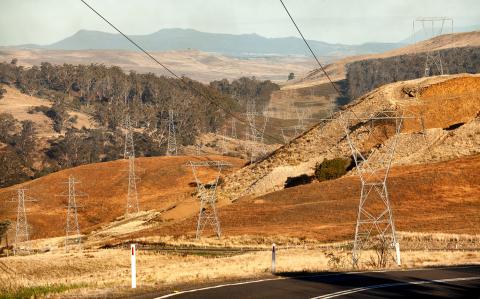IEEFA Energy Swamp Watch: The Puerto Rico Electric Power Authority Would Starve Its Electric Grid to Pay Its Bondholders

 This blog starts a series we’re calling the IEEFA Energy Swamp Watch, in which we’ll describe the imprudence in some of the unseemly, wasteful and abusive financial practices we run across in our research.
This blog starts a series we’re calling the IEEFA Energy Swamp Watch, in which we’ll describe the imprudence in some of the unseemly, wasteful and abusive financial practices we run across in our research.
Most of the questionable activity we see is within the bounds of law—which is not the same as being within the bounds of common sense. The projects and transactions we question in most cases could be corrected with timely, relevant and thoughtful leadership, which is to say better leadership.
Today, IEEFA Energy Swamp Watch cites the consultants, the underwriting team, the bondholders, the oil interests and upper-level management behind the debt crisis at the Puerto Rico Electric Power Authority (PREPA).
We’ve studied the PREPA situation extensively. In August we published our findings in a detailed report critical of the agency’s executives and consultants, in October we submitted testimony in a crucial PREPA rate case, and last week we attended public hearings on how the agency is hobbling Puerto Rico’s economy.
Upgrades of PREPA’s physical plant—that is, its generation, transmission and distribution systems—are long overdue. Some parts of the system are in an obviously dangerous state of physical disrepair, and we wonder at how there haven’t been more outages like the three-day blackout that crippled the island in September.
PREPA is facing an administrative and financial emergency, too, as those in charge of carrying out day-to-day functions, some as basic as maintaining meters, are without sufficient resources to do their job.
Deeper trouble lurks in the authority’s thin capacity for planning and building for the future.
If PREPA stays its poor course, Puerto Rico will miss out on perhaps a once-in-a-lifetime opportunity to modernize its rickety electrical system.
We’ve noted before how PREPA consultants this year negotiated a deal (that has not yet closed) to refinance PREPA’s $9.5 billion outstanding debt. The agreement would net a reduction in principal, but it would be too small to have any meaningful impact.
The agency’s current overall rate increase request is likely to be considerably higher than the initially proposed rate request of 20 cents per kWh. The increase is driven by three recent major changes: 1) a $460 million unbudgeted increase in the cost of fuel for 2017 (due to an agency underestimate); 2) an additional unbudgeted $125 million for debt service coverage (due also to an agency underestimate); and 3) a reduction in much-needed capital expenditures that ultimately will only increase this investment requirement.
According to an official filing by PREPA, rates were to go originally from 17.79 cents per kilowatt-hour to 20.1 cents per kWh from 2016 to 2017, a 13 percent increase. At last week’s hearing, Puerto Rico Energy Commission experts updated PREPA’s budget estimates. From those numbers, we see rates rising to about 22.6 cents per kWh, a 27 percent increase.
THE PRIORITIES OF PREPA EXECUTIVES AND THEIR ADVISORS ARE CLEAR: THEY ARE EARMARKING MORE MONEY FOR OIL, MORE MONEY FOR DEBT SERVICE AND LESS MONEY FOR CAPITAL IMPROVEMENTS. This strategy undermines everything and everyone at PREPA, including mid-level managers who are responsible for operating the system. These are a committed group of professionals who live in Puerto Rico and who perform daily miracles with few resources and with the foot of bondholders, PREPA consultants and upper-level PREPA management on their throats.
PREPA will spend $149 million for capital improvements in 2017 and $943 million to pay off old debt. That means that for every $1 spent on system upgrades, $7 will go to debt service. It’s an out-of-whack ratio that benefits off-island interests at the expense of Puerto Rico residents.
Almost 50 percent of PREPA’s budget will go to fossil-fuel companies to pay for fuel. The remainder of the operations budget—including for generation, transmission and distribution system maintenance—will account for only 18 percent of the PREPA rate dollar.
So PREPA is proposing to starve its electric grid to collect the maximum amount for bondholders. It’s a reckless strategy rooted in the peculiar demands of PREPA’s bond consultants and the bondholders they represent. These parties have negotiated a debt deal that requires that many of PREPA’s creditors be paid 100 percent on the dollar and that the others receive 85 cents on the dollar.
We say “peculiar” because bondholders like Franklin Templeton, Oppenheimer, Goldman Sachs, T. Rowe Price and Vanguard are long-term investors. They put money into PREPA revenue bonds that were said to carry minimal risk and provide high recovery rates in the unlikely event of default. The fundamental assumption of bondholders always is that the value of the underlying asset is in a state of good repair. But that was an off-the-mark assumption with PREPA. PREPA in fact cannot continue to operate, invest in necessary new infrastructure, and pay off $8.4 billion in debt over the next 20 years.
When an electricity system borrows too much money, its financial stress can be worked out in negotiations with bondholders. When an electricity system borrows too much time, nature takes its course. Nature does not negotiate.
Tom Sanzillo is IEEFA’s director of finance.
RELATED POSTS:
IEEFA Puerto Rico: The Hidden Boogeyman in the Commonwealth’s Debt Crisis















